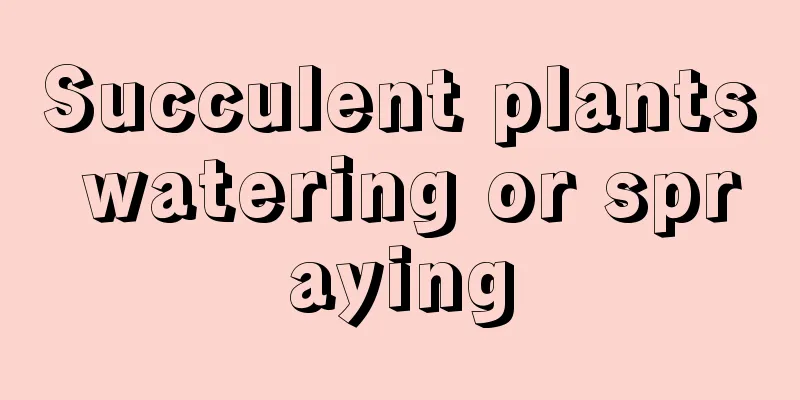Succulent plants watering or spraying

|
When caring for succulents, watering and spraying are often used to replenish water, but watering and spraying have completely different effects. The choice should be based on the dryness of the air and the dryness of the soil. Different watering methods are used in different seasons. 1. SpringThe temperature rises in spring, and succulents have begun to "wake up" after a long winter. Spring is their growing season, and they need more water. At this time, simply replenishing water through spraying cannot meet their growth needs, so watering is needed. The evaporation rate in spring is not very large, so when watering, do not water directly from the top of the plant to avoid water accumulation in the center of the plant and causing rot. Succulent plants are generally small in size. We can use a pointed kettle or a used mineral water bottle to poke a few holes, pour water into the culture soil, and water it thoroughly. 2. SummerThe weather is relatively hot in midsummer and the light is very strong. This type of plant is prone to black rot in the summer. While providing appropriate shade, it is also necessary to maintain sufficient moisture. Therefore, watering should be used to replenish water in the summer, but water accumulation must be avoided. The high temperatures in summer are accompanied by dry indoor air and accelerated evaporation. Most succulents are foliage plants, so it is very important to increase the air humidity by spraying. When caring for the plants in summer, you should pay attention to combining watering and spraying to add moisture to the soil and increase the humidity of the air to ensure the beauty of the leaves. AutumnThe air remains dry from autumn to winter, especially for succulents kept indoors. Without the nourishment of morning dew, the air is extremely dry indoors and needs to absorb water to keep the leaves plump. However, the temperature will gradually drop in autumn and the evaporation effect will weaken. Too much watering will cause waterlogging and root rot, so we can reduce watering and increase spraying to maintain air humidity. 4. WinterThe temperature drops significantly this season. In order to avoid frostbite, watering and spraying must be controlled to control water and keep warm to help plants survive the winter. |
>>: Can succulents be sprayed with nutrient solution?
Recommend
What are the matching flowers?
1. Baby's breath Gypsophila is a common match...
Introduction to common varieties of Gyokuro
Purple Skin Jade Dew Purple-skinned Jade is actua...
How long is the growth cycle of mustard?
Introduction to Mustard Growth Mustard is mostly ...
How to sow with high snow wheel
Seeding management The high snow wheel has a stro...
How to grow mint hydroponically
1. Cut suitable hydroponic branches If we want to...
Can camphor trees be planted outside the house?
Can camphor trees be planted at the doorstep? Cam...
How to grow geranium in summer
7 elements of geranium summer care 1. If you plan...
Can you grow succulents in ordinary soil?
Can ordinary soil grow succulents? Succulents can...
Aloe vera varieties, characteristics of aloe vera
1. Aloe Vera Varieties 1. Chinese Aloe: There are...
How to effectively prevent asparagus fern from drying out
1. Not enough water 1. Reasons First, it likes wa...
Can papaya be eaten directly? What are the benefits of eating papaya?
1. Can I eat it directly? Papaya can be eaten dir...
How many kilograms of soybean seeds are needed per acre?
In soybean cultivation, determining a reasonable ...
Just learn a few simple tricks and your bougainvillea can grow into a waterfall and bloom into a sea of flowers!
How to water bougainvillea Water once every five ...
How to make the red flower jade produce small balls
illumination The red flower jade likes sunlight a...
Can rabbit feces be used as fertilizer? (Can rabbit feces be used directly as fertilizer?)
Spring is here, and it's time to fertilize th...









